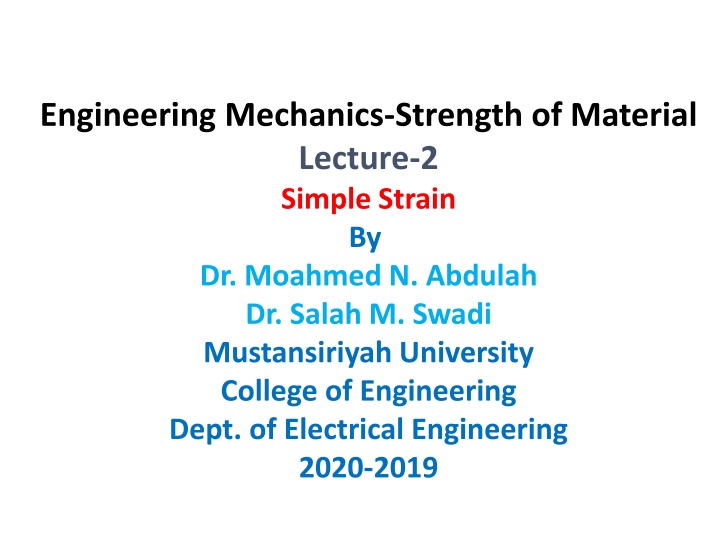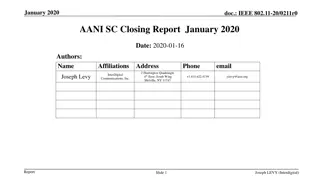
Understanding Simple Strain and Stress-Strain Diagram in Materials Engineering
Delve into the concepts of simple strain, stress-strain diagrams, and the classification of metallic engineering materials as ductile or brittle. Learn about Hooke's Law, the proportional limit, and the elastic limit in materials testing. Gain insights into the behavior of different materials under applied forces and their corresponding stress-strain relationships.
Download Presentation

Please find below an Image/Link to download the presentation.
The content on the website is provided AS IS for your information and personal use only. It may not be sold, licensed, or shared on other websites without obtaining consent from the author. If you encounter any issues during the download, it is possible that the publisher has removed the file from their server.
You are allowed to download the files provided on this website for personal or commercial use, subject to the condition that they are used lawfully. All files are the property of their respective owners.
The content on the website is provided AS IS for your information and personal use only. It may not be sold, licensed, or shared on other websites without obtaining consent from the author.
E N D
Presentation Transcript
Engineering Mechanics-Strength of Material Lecture-2 Simple Strain By Dr. Moahmed N. Abdulah Dr. Salah M. Swadi Mustansiriyah University College of Engineering Dept. of Electrical Engineering 2020-2019
Simple Strain Also known as unit deformation, strain is the ratio of the change in length caused by the applied force, to the original length. where is the deformation and L is the original length, thus is dimensionless.
Stress-Strain Diagram Suppose that a metal specimen be placed in tension-compression testing machine. As the axial load is gradually increased in increments, the total elongation over the gage length is measured at each increment of the load and this is continued until failure of the specimen takes place. Knowing the original cross- sectional area and length of the specimen, the normal stress and the strain can be obtained. The graph of these quantities with the stress along the y-axis and the strain along the x-axis is called the stress-strain diagram. The stress-strain diagram differs in form for various materials. The diagram shown below is that for a medium carbon structural steel.
Metallic engineering materials are classified as either ductile or brittle materials. A ductile material is one having relatively large tensile strains up to the point of rupture like structural steel and aluminum, whereas brittle materials has a relatively small strain up to the point of rupture like cast iron and concrete. An arbitrary strain of 0.05 mm/mm is frequently taken as the dividing line between these two classes. ?? ???? ????? ?????? ????????? ?????= ?.? =
PROPORTIONAL LIMIT (HOOKE'S LAW) From the origin O to the point called proportional limit, the stress- strain curve is a straight line. This linear relation between elongation and the axial force causing was first noticed by Sir Robert Hooke in 1678 and is called Hooke's Law that within the proportional limit, the stress is directly proportional to strain or The ? ? ?? ? = ? ? The constant of proportionality k is called the Modulus of Elasticity E or Young's Modulus ( Thomas Young/ British Scientist) and is equal to the slope of the stress-strain diagram from O to P. Then ? = ??
ELASTIC LIMIT The elastic limit is the limit beyond which the material will no longer go back to its original shape when the load is removed, or it is the maximum stress that may e developed such that there is no permanent or residual deformation when the load is entirely removed. ELASTIC AND PLASTIC RANGES The region in stress-strain diagram from O to P is called the elastic range. The region from P to R is called the plastic range. YIELD POINT Yield point is the point at which the material will have an appreciable elongation or yielding without any increase in load.
ULTIMATE STRENGTH The maximum ordinate in the stress-strain diagram is the ultimate strength or tensile strength. AXIAL DEFORMATION In the linear portion of the stress-strain diagram, the tress is proportional to strain and is given by = E since = P / A and = / L, then P / A = E / L. Solving for , To use this formula, the load must be axial, the bar must have a uniform cross-sectional area, and the stress must not exceed the proportional limit
Example1/A steel rod having a cross-sectional area of 300 mm2and a length of 150 m is suspended vertically from one end. It supports a tensile load of 20 kN at the lower end. If the unit mass of steel is 7850 kg/m3 and E = 200 GN/m2, find the total elongation of the rod ?? ?? ? =
Example2/ A steel wire 30 ft long, hanging vertically, supports a load of 500 lb. Neglecting the weight of the wire, determine the required diameter if the stress is not to exceed 20 ksi and the total elongation is not to exceed 0.20 in. Assume E = 29 106psi.
Example.3/ An aluminum bar having a cross-sectional area of 0.5 in2carries the axial loads applied at the positions shown in Fig. P-209. Compute the total change in length of the bar if E = 10 106psi. Assume the bar is suitably braced to prevent lateral buckling.
Example.4/ Solve Prob. 209 if the points of application of the 6000-lb and the 4000-lb forces are interchanged
Example. 5/ A bronze bar is fastened between a steel bar and an aluminum bar as shown in Fig. P-211. Axial loads are applied at the positions indicated. Find the largest value of P that will not exceed an overall deformation of 3.0 mm, or the following stresses: 140 MPa in the steel, 120 MPa in the bronze, and 80 MPa in the aluminum. Assume that the assembly is suitably braced to prevent buckling. Use Est = 200 GPa, Eal = 70 GPa, and Ebr = 83 GPa.
Example. 6/ The rigid bar ABC shown in Fig. P-212 is hinged at A and supported by a steel rod at B. Determine the largest load P that can be applied at C if the stress in the steel rod is limited to 30 ksi and the vertical movement of end C must not exceed 0.10 in.
Example.7/ The rigid bar AB, attached to two vertical rods as shown in Fig. P-213, is horizontal before the load P is applied. Determine the vertical movement of P if its magnitude is 50 kN.
Example. 8/ A uniform concrete slab of total weight W is to be attached, as shown in Fig. P- 215, to two rods whose lower ends are on the same level. Determine the ratio of the areas of the rods so that the slab will remain level.
















